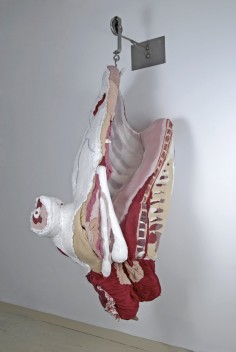Tamara Kostianovsky
Venus
source: highlike
Work: An interest in exploring the physicality of the body through the use of humble materials, led me to use my own clothing for the creation of artworks. In the year 2008, I proceeded to “cannibalize” my entire wardrobe in order to make naturalistic sculptures of slaughtered cattle. “Venus” belongs to this series of works and uses a visceral imagery to focus the attention on the topic of violence.
Photographer: Sol Aramendi
.
.
.
.
.
.
.
source: i-refde
Der erste Eindruck mag ein brutaler sein, doch wir können Entwarnung geben: Die Kadaver aus Tamara Kostianovskys Projekt “Actus Reus” sind weder blutig noch tot, und Tiere sind dabei auch nicht zu Schaden gekommen. Es handelt sich lediglich um verstorbene Klamotten.
Als Tamara im Jahre 2000 in New York ankam, hatte sie vor allem Angst vor einem: Der Kälte. Dementsprechend waren ihre Koffer mit warmen Pullovern überfüllt. Und was macht man als Künstler mit überquellenden Schränken? Richtig: Man verwandelt sie in Kunst. Es gehört zu Tamaras Prinzipien als Material für ihre Kunstwerke nur eigene oder gespendete gebrauchte Sachen zu verwenden. So haben ihre Werke neben der offensichtlichen Aussage über die Brutalität von Tiermord, auch eine persönliche Bedeutung, denn jedes Element, das in ihnen verarbeitet wurde war ein Kleidungsstück mit einer Geschichte und mit Erinnerungen.
“For the creation of these works I cannibalized my clothes: I used fabrics and textures to conjure flesh, bone gristle and slabs of fat in life-size sculptures of livestock carcasses. My intention is to confront the viewers with the real and grotesque nature of violence, offering a context for reflecting about the vulnerability of our physical existences, brutality, poverty, consumption, and the voracious needs of the body.”
Als Kind wuchs Tamara in Argentinien auf und wurde oft Zeuge von Tierschlachtungen und der damit einhergehenden groben Gewalt, welche sich wie ein Brandmal in ihr Gedächtnis einprägte. Ihr späteres Engagement in künstlerischen Aktivitäten weckte das Verlangen diese Bilder zu materialisieren.
“I felt that these images were powerful and could tell a lot. About my history, about the country’s history. Over time I realized that this story of violence and consumption is a universal story. Its not the story from Tamara from Argentina, but its a story of the world.”
.
.
.
.
.
.
.
source: limlife
肉ってすごい存在感ありますね。N.Y.ベースのアーティスト、Tamara Kostianovskyさんの作品です。 ファブリックやテクスチャーで解体肉を再現しています。 精巧に出来てはいるのですが、やはり 素材はいかんともしがたく、どことなく柔らかい印象です。 しかし、問題はそこではなく 言ってし まえばフェイクまるわかりでも、 いやフェイクそのものだからこそ 「肉塊」の存在感やインパクトが浮き彫りになるのです。
.
.
.
.
.
.
.
.
source: uniknya
Biasanya kita melihat maket, miniatur hiasan daging terbuat dari lilin, plastik, kayu dan sebagainya. Namun kali ini kita akan melihat sajian instalasi karya Tamara Kostianovsky yang disusun dari bahan-bahan tekstil, pakaian dan celana dalam, dan banyak lagi. Dalam proyek ‘Actus Reus’, seniman asal New York ini merelakan semua pakaian untuk dijadikan material instalasi dedagingan. Berikut instalasi daging karya Tamara Kostianovsky.
.
.
.
.
.
.
.
source: gforg
Tamara Kostianovsky was born in Jerusalem, Israel, in 1974 and grew up in Buenos Aires, Argentina. Her installations and sculptures confront the viewers with the real and grotesque nature of violence, offering a context to reflect on the vulnerability of our physical existence. Her work questions unchecked brutality while investigating the relationships between poverty, consumption, and desire, hoping to create a model of the architecture of violence.
She literally cannibalizes her wardrobe into art—using the various fabrics and textures to conjure flesh, bone, gristle, and slabs of fat in life-size sculptures of livestock carcasses. The material connects our bodies with the ones in the work, bringing violent acts into a familiar realm.
Kostianovsky earned her undergraduate degree from the National School of Fine Arts “Prilidiano Pueyrredon” in Buenos Aires, Argentina (1998) and a Master of Fine Arts degree from the Pennsylvania Academy of the Fine Arts in Philadelphia (2003).
In addition to her Guggenheim Fellowship, Kostianovsky has been awarded numerous grants and fellowships. Selected awards include the New York Foundation for the Arts (2009), Socrates Sculpture Park (2009), the Pollock-Krasner Foundation (2008), and The Pennsylvania Council on the Arts (2005).
Solo exhibitions include Black and White Gallery and VOLTA, both in New York City; The Philadelphia Museum of Jewish Art; and Centro Cultural J. L. Borges, Buenos Aires, Argentina. Amongst other venues, her work has been presented in group exhibitions at The Jewish Museum, El Museo del Barrio,Exit Art, and Socrates Sculpture Park, all in New York City; Scion Installation in Los Angeles; The University of the Arts, Philadelphia; and Pierre Menard Gallery, Cambridge, Massachusetts.
Kostianovsky currently lives and works in New York and is a faculty member at the School of Visual Arts.


